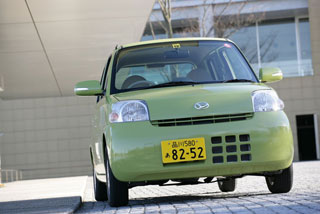Daihatsu Esse (J) test drive since 2006 -
Daihatsu Esse vehicles in configuration x
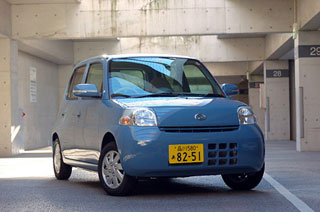 Daihatsu has begun the production of a new small -leaf Esse car, the base for which was the well -known Daihatsu Mira model. What is the difference between these two cars? Firstly, the Esse car has a brighter appearance, and secondly, it is more economical. It should also be noted that this model appeared against the backdrop of a tense competition, which unfolded between two companies producing low -command Daihatsu and Suzuki. And so I go to the place to execute a test trip behind the wheel of this strategically important car for the company Daihatsu.
Daihatsu has begun the production of a new small -leaf Esse car, the base for which was the well -known Daihatsu Mira model. What is the difference between these two cars? Firstly, the Esse car has a brighter appearance, and secondly, it is more economical. It should also be noted that this model appeared against the backdrop of a tense competition, which unfolded between two companies producing low -command Daihatsu and Suzuki. And so I go to the place to execute a test trip behind the wheel of this strategically important car for the company Daihatsu. Today - the extremely low price.
During the discussion of various aspects of the new Esse car, I touched on the issue of the formation of its realization price. In particular, I asked how the refusal to cover the ceiling of the cabin reflected at the cost. The response of the company representative confused me a little, since a special term was used in it, at that time it was incomprehensible. The engineer uttered the phrase the cost of the form. It turns out that this means nothing more than the costs of making press forms for stamping the necessary sheet parts. Well, I will keep this in mind. At first glance, the Esse car does not resemble a very cheap car at all, although its price is quite low. This result was achieved thanks to the above economy.
I will say a well -known fact, but in terms of technical characteristics, the micro -lunch machine will never reach the level of a representative of a representative class at a price of 10 million yen. Therefore, the main trump card of low -profile is not high technical data, but the lowest price. Now, due to the fact that between Suzuki and Daihatsu, an unprecedented struggle has unfolded for first place in the domestic Japanese market of small vehicles, the level of requirements for them is becoming higher and higher. One of these requirements is reduced. And this is what happens today. The simplest and, naturally, inexpensive modification of the Esse car (it is indicated by the letter combination of ECO), costs only 682.5 thousand yen. This is almost the same price at which the cheapest Suzuki Alto car is sold. Such a price unanimity of two competing companies can only mean that it is simply impossible to make the price even lower at date. As they say, the limit is exhausted!
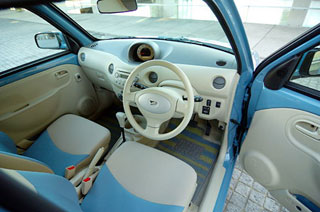 Before launching its new Esse model to the market, Daihatsu spent a lot of effort and energy on the development and improvement of the production of its Mira base model. I must say that the main thing that the designers achieved was to make the car as practical as possible. And what about the Esse machine? Here the manufacturer decided to slightly change the tactics. Therefore, the concept of an Esse car can be formulated a little differently: a car of a mini -mini -driving class car, uncomplicated, but necessarily bright. Indirectly, this plan found its confirmation that the singer Kuroki Hitomi was connected to the advertising company of this car. Agree, this is a very indicative fact. However, all this is only the external side of the issue. In fact, no matter how beautiful the car may not work if it turns out to be uneconomical and impractical.
Before launching its new Esse model to the market, Daihatsu spent a lot of effort and energy on the development and improvement of the production of its Mira base model. I must say that the main thing that the designers achieved was to make the car as practical as possible. And what about the Esse machine? Here the manufacturer decided to slightly change the tactics. Therefore, the concept of an Esse car can be formulated a little differently: a car of a mini -mini -driving class car, uncomplicated, but necessarily bright. Indirectly, this plan found its confirmation that the singer Kuroki Hitomi was connected to the advertising company of this car. Agree, this is a very indicative fact. However, all this is only the external side of the issue. In fact, no matter how beautiful the car may not work if it turns out to be uneconomical and impractical. A lot has been spent on the engine!
On the pages of Navi magazine, journalist Siomi Taythee expressed that the new Esse model could be called Daihatsu March. I partly agree, rounded forms of the body will undoubtedly attract the attention of young girls. Yes, and its front, which for expressiveness is sometimes called a car face, also gave such a pleasant expression that there is a sight of sight. The same can be said about the selection of interior colors. In fact, pastel colors in the cabin - for whom, if not for girls of drivers, this color is designed?! Although it should be recognized that, unlike the previous experiments of creating female machines, where this feminine principle was striking and caused controversial feelings, in the new Esse machine all this was done with taste. But not everything turns out as well as we would like, it is difficult to disagree with Navi magazine. You just look at the front panel of the cabin! I immediately, as I looked at her, had a firm confidence that I had already seen it all somewhere. Well, of course! This is one to one element of the interior from the Nissan March car. But let me, to make a car is cheaper, this is a good goal, who argues. But you can’t do this through a refusal to search for new design solutions!
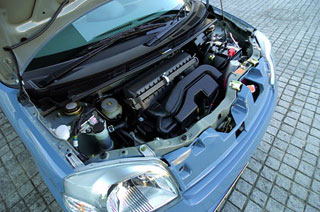 At the same time, which a lot of money was really spent on is on the engine. I will not be able to convey all my emotions at the sight of this motor, if only because few people are generally interested in how and what works under the car under the hood. But, you must admit, there is a certain intrigue that the previous model of the evaluated engine was developed as many as 20 years ago. At that time, however, it was the EF-VD series engine, and now it is listed under the letters of KF-VE, but the main signs remained the same. Both engines have 3 cylinders, and the gas distribution mechanism is also similar, a 12-valve structure. But there is a huge difference between them. And, above all, an enlarged working piston. If you characterize the cylinders according to the formula for the diameter of the piston x the work piston work, then the following picture is obtained. In the previous engines, this proportion looked like 68.0 x 60.5 mm, and in a new version - 63.0 x 70.4 mm. As you can see, while other companies are trying to reduce the working piston work, Daihatsu designers do the opposite. What is it for?
At the same time, which a lot of money was really spent on is on the engine. I will not be able to convey all my emotions at the sight of this motor, if only because few people are generally interested in how and what works under the car under the hood. But, you must admit, there is a certain intrigue that the previous model of the evaluated engine was developed as many as 20 years ago. At that time, however, it was the EF-VD series engine, and now it is listed under the letters of KF-VE, but the main signs remained the same. Both engines have 3 cylinders, and the gas distribution mechanism is also similar, a 12-valve structure. But there is a huge difference between them. And, above all, an enlarged working piston. If you characterize the cylinders according to the formula for the diameter of the piston x the work piston work, then the following picture is obtained. In the previous engines, this proportion looked like 68.0 x 60.5 mm, and in a new version - 63.0 x 70.4 mm. As you can see, while other companies are trying to reduce the working piston work, Daihatsu designers do the opposite. What is it for? The benefit of increasing the stroke of the piston is that there is a relatively powerful torque at low speeds. However, in this case, the peak of maximum power occurs later. In addition, lengthening the piston stroke, we force it to move at a higher pace, which increases the load on all nodes and parts. According to the explanations that one of the company's engineers gave me, during the modernization I had to give great strength to the piston rings. This made it possible to achieve the same maximum speed that was in the engine of the previous model. Further, despite the fact that the diameter of the cylinder has become smaller, the valve channels remained the previous section. This has avoided possible problems with the intake system. As a result of the measures taken, the power of the motor fell by 2 horsepower, but the value of the maximum torque remained the same. This made it possible to improve acceleration dynamics. Judge for yourself: the Mira car overcomes a distance from 0 to 30 meters in 4.4 seconds, and the new ESSE machine has this indicator for two tenths of a second.
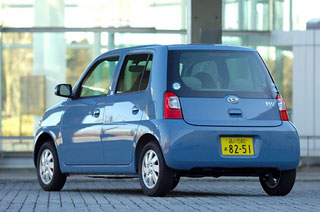 Details in the style of retro.
Details in the style of retro. The testing trip was supposed to take place in the area of \u200b\u200bthe Kadzus Academic Park, on the same highway where I experienced Mira Gino model some time ago. Therefore, it was possible to evaluate the new Esse car, so to speak, by comparison. Immediately after leaving there, there is a rather steep rise, on which the Mira Gino car, I remember, climbed, panting on the go. At the same speed of rise, the Esse machine coped with the task easily and at ease. What is the reason, you ask? Yes, it is likely that the ESSE engine, as has already been noted, has the best indicators of torque at low and medium speeds. That is, it is impossible to call a more powerful motor, it really lost 2 horsepower, but, as it turns out, this did not affect the traction characteristics of the machine, even vice versa.
Between the turn of the steering wheel and the subsequent start of turning to the right or left, I felt some delay. In the cabin, a small vibration is constantly felt, which the driver feels in the area of \u200b\u200bthe lower back. The driver’s seat is not very comfortable, the depth of seats, whether it is the front or rear seats, cannot be called sufficient. The luggage compartment has uneven walls due to the hind wheels outstanding inside. In a word, if you set the goal, then you can list the shortcomings for a very long time. But you can, for example, evaluate the light of the salon. In this case, the assessment will be positive. In the upper part of the cabin, as has already been noted, it was decided to refuse upholstery, which is why the car began to be a little like a retro -style car.
So what do we have? For an amount not exceeding 1 million yen, we are offered a car that is endowed with a pleasant appearance and has excellent traction characteristics. The appearance of the machine is captured in a typical manner for Japanese automobile architects. But behind these pleasant manners lies a design with a very solid character. Of course, this car cannot be called a machine that will become a revelation for true experts. But, I dare to assure that she deserves respect.
Technical characteristics of the machine:
Length 3395 mm x width 1475 mm x height 1470 mm.
Wheel base: 2390 mm.
Machine weight: 720 kg.
Drive: front
Engine: working volume of cylinders 660 cubic meters. See, developed power 58 hp. at 7200 rpm, the largest torque of 6.6 kg/m at 4000 rpm.
The basic price of the car: 924 thousand yen.
The price of the machine on which the test trip was performed: 1 million 27.5 thousand yen. The difference in price is due to the installation of the ABS system (+31.5 thousand yen), a plasma cluster (+15.75 thousand yen) and 13-inch aluminum wheels (+31.5 thousand yen).
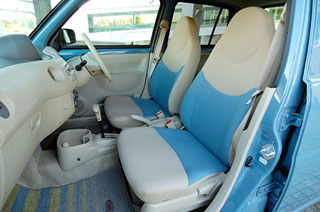
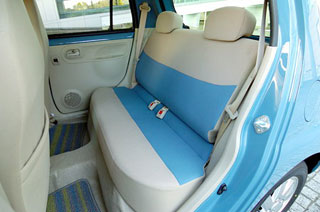
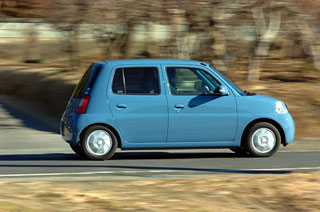
Source: Webcg.net

_2006_-_nv_1.jpg)
_2006_-_nv_2.jpg)
_2006_-_nv_3.jpg)



